IQD – Iraqi Dinar
Monetary System
01.04.1932: 1 Iraqi dinar (IQD) = 1,000 fils
2013 – 2020 Issues
These notes have intaglio symbols at left front for the sight impaired, as well as other enhanced security features.
Description: 5,000.00 IQD – Iraqi Dinar Size: 159 x 78 mm
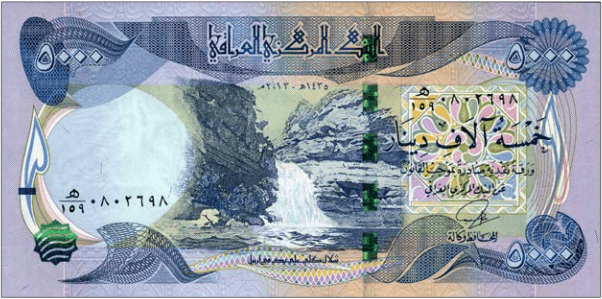
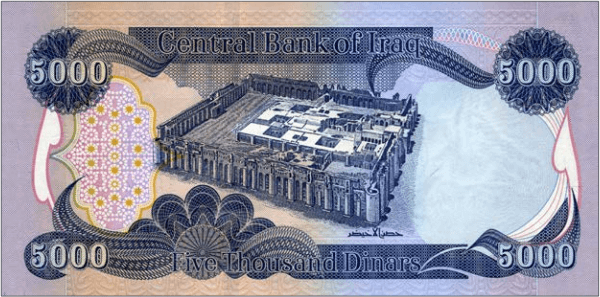
Purple, blue, and orange. Front: Arabic text; green-to-blue SPARK feature; Gali Ali Beg waterfall in Kurdistan. Back: English text; desert fortress of Al-Ukhether. 4-mm wide green-to-blue RollingStar Cube windowed security thread with demetalized Arabic text. Watermark: Horse head. Printer: (Giesecke & Devrient). 159 x 78 mm. Paper.
Description: 10,000.00 IQD – Iraqi Dinar Size: 170 x 78 mm

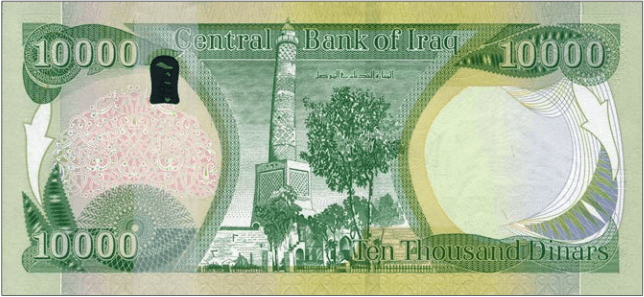
Green. Front: Arabic text; gold-to-green SPARK feature; sculptor Jawad Saleem’s Freedom Monument in Baghdad. Back: English text; al-Hadba’ (the hunchback) minaret and trees at the Great Nur al-Din mosque in Mosul. varifeye thread and RollingStar Cube windowed security thread with demetalized Arabic text. Watermark: Horse head. Printer: (Giesecke & Devrient). 170 x 78 mm. Paper.
Description: 25,000.00 IQD – Iraqi Dinar Size: 177 x 78 mm
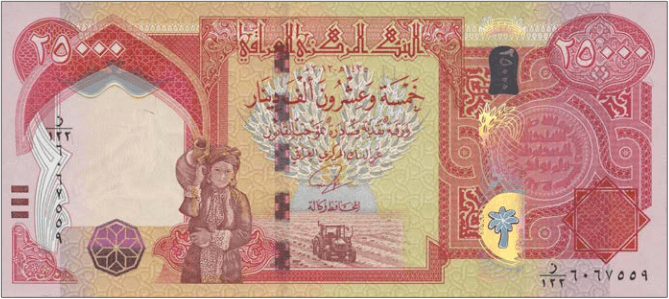
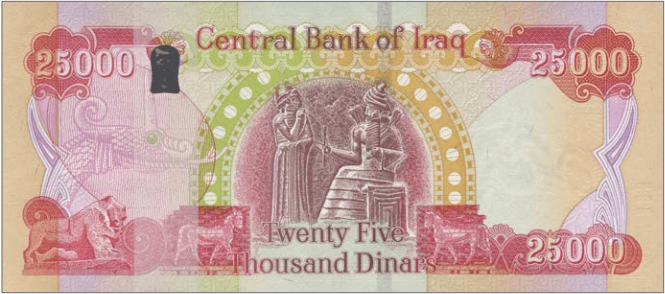
Red and yellow. Front: Arabic text; purple SPARK feature; woman carrying jug on shoulder; modern tractor plowing field. Back: English text; Lion of Babylon; snake carving; horses; Babylonian king, Hammurabi, receiving laws from Shamash the Sun God, as depicted on carving from upper part of diorite stele of Code of Hammurabi. varifeye thread and 4-mm wide purple-to-green RollingStar Cube windowed security thread with demetalized Arabic text. Watermark: Horse head. Printer: (Giesecke & Devrient). 177 x 78 mm. Paper.
Description: 50,000.00 IQD – Iraqi Dinar Size: 156 x 65 mm
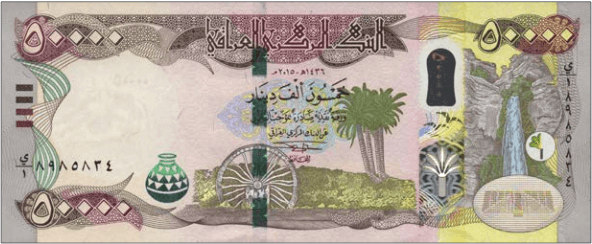
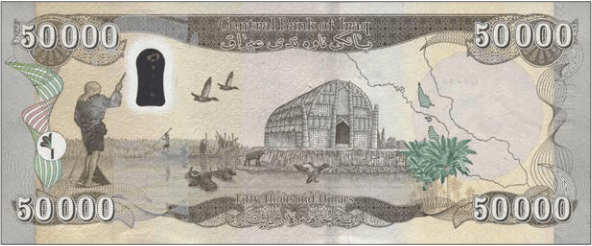
Brown, green, yellow, and blue. Front: Arabic text; Assyrian jar in blue-to-green SPARK; water wheel on the Euphrates river; palm trees; flying birds; Gali Ali Beg waterfall in Kurdistan; Assyrian palm tree as registration device. Back: English and Kurdish text; Assyrian palm tree; fishermen poling canoes through marshes with flying ducks, water buffalos, reed house; outline map of Iraq showing Euphrates and Tigris rivers; palm trees. varifeye thread with spiral minaret, Malwiya Tower, at the Great Mosque of Samarra. 4-mm wide purple-to-green RollingStar Cube windowed security thread with demetalized Arabic text (The Central Bank of Iraq). Watermark: Horse head and electrotype 50000. Printer: (Giesecke & Devrient). 156 x 65 mm. Paper.
2018 Issues
In October 2018, the Central Bank of Iraq introduced the first three denominations in a new series of banknote designs aimed at modernizing the currency and better reflecting the nation’s heritage and diversity. As part of the redesign, the new banknotes will now feature the governor of the central bank’s printed name instead of his signature. New 10,000- and 25,000-dinar notes were also announced, but no details have been revealed about same.
Description: 1,000.00 IQD – Iraqi Dinar Size: 142 x 66 mm
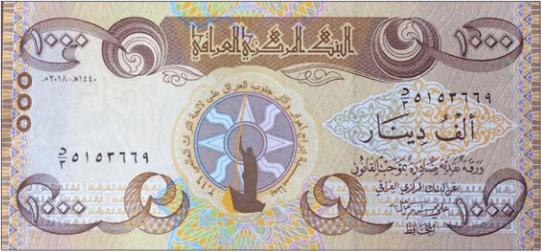
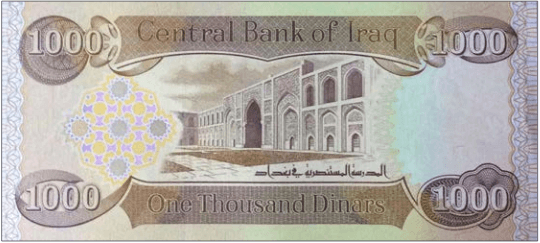
Brown. Front: Arabic text; silhoutte of man standing in boat holding pole with Assyrian star in background. Back: English text; Mustansiriya Madrasah building in Baghdad. Solid security thread with demetalized Arabic text. Watermark: Horse head. Printer: (Unknown). 142 x 66 mm. Paper.
2003 – 2013 Issues
Between 15 October 2003 and 15 January 2004, the Coalition Provisional Authority issued new Iraqi dinar coins and notes, with the notes designed and printed (except for the 250-dinar note) by Thomas De La Rue using modern anti-forgery techniques, to “create a single unified currency that is used throughout all of Iraq and will also make money more convenient to use in people’s everyday lives.” Old banknotes were exchanged for new at a one-to-one rate, except for the “Swiss” dinars, which were exchanged at a rate of 150 new dinars for one Swiss dinar.
In 2014, the bank began issuing notes with intaglio symbols at left front for the sight impaired.
Description: 1,000.00 IQD – Iraqi Dinar Size: 142 x 66 mm
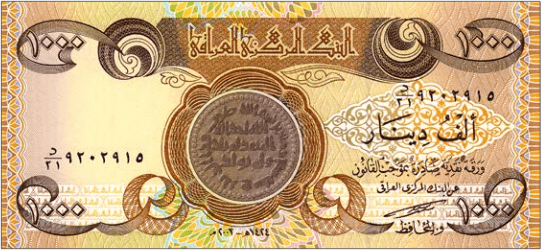

Brown. Front: Arabic text; ancient gold dinar coin. Back: English text; Mustansiriya Madrasah building in Baghdad. Solid security thread with demetalized Arabic text. Watermark: Horse head. Printer: (De La Rue). 142 x 66 mm. Paper.
Description: 5,000.00 IQD – Iraqi Dinar Size: 159 x 78 mm
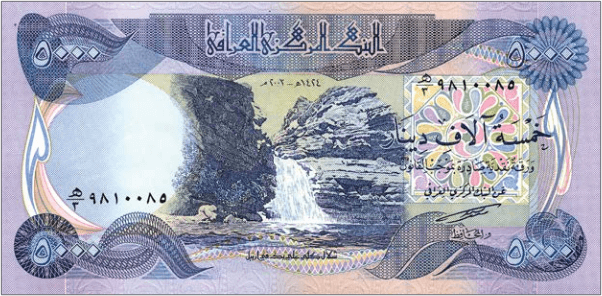
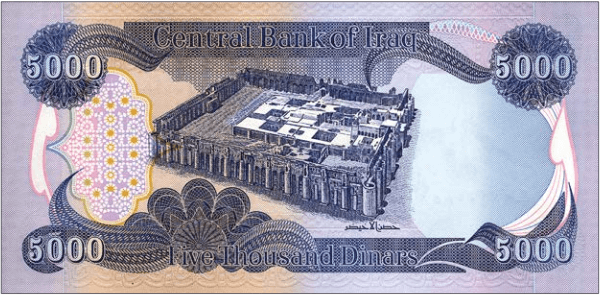
Purple, blue, and orange. Front: Arabic text; Gali Ali Beg waterfall in Kurdistan. Back: English text; desert fortress of Al-Ukhether. Solid security thread with demetalized Arabic text. Watermark: Horse head. Printer: (De La Rue). 159 x 78 mm. Paper.
Description: 10,000.00 IQD – Iraqi Dinar Size: 170 x 78 mm
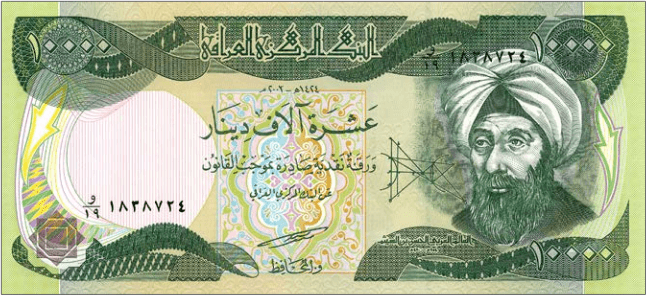
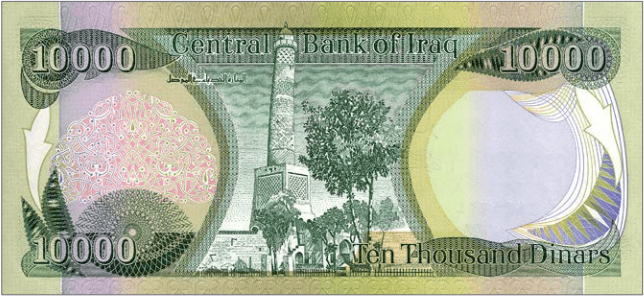
Green. Front: Arabic text; geometric drawing of optics; scientist Abū ‘Alī al-Hasan ibn al-Hasan ibn al-Haytham (also known as Alhazen). Back: English text; al-Hadba’ (the hunchback) minaret and trees at the Great Nur al-Din mosque in Mosul. Solid security thread with demetalized Arabic text. Watermark: Horse head. Printer: (De La Rue). 170 x 78 mm. Paper.
Description: 25,000.00 IQD – Iraqi Dinar Size: 177 x 78 mm
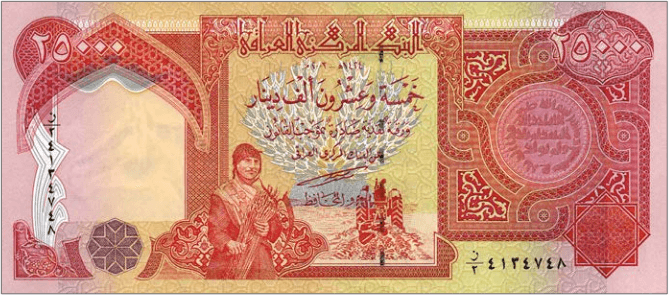
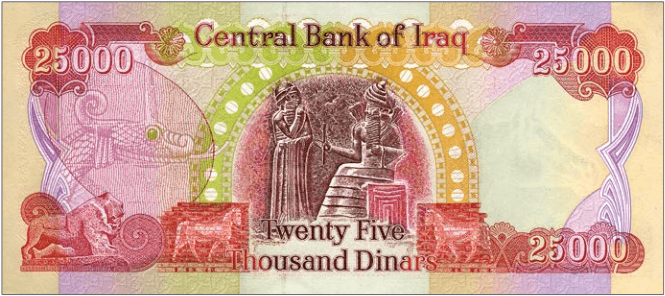
Red and yellow. Front: Arabic text; female Kurdish farmer holding sheaf of wheat; modern tractor plowing field. Back: English text; Lion of Babylon; snake carving; horses; Babylonian king, Hammurabi, receiving laws from Shamash the Sun God, as depicted on carving from upper part of diorite stele of Code of Hammurabi. Windowed security thread with demetalized Arabic text. Watermark: Horse head. Printer: (De La Rue). 177 x 78 mm. Paper.
Government of Iraq
When Iraq was part of the Ottoman Empire, several European currencies circulated alongside the Turkish pound. With the establishment of the British mandate on 2 March 1921 following World War I, Iraq was incorporated into the Indian monetary system operated by the British, and the rupee became the principal currency. In 1931 the Iraq Currency Board was established in London to issue notes for the Government of Iraq (GOV).
More Information
• According to an article in Alsumaria, on 23 June 2011 the Central Bank of Iraq announced it is planning to delete three zeros from the Iraqi dinar, and add Kurdish to the Arabic text on the notes. Said the adviser of Iraqi Central Bank governor Mothahhar Mohammed Saleh, “The project of deleting zeroes is complete. It will be submitted to the central bank’s administration in the next session. Then, it will be passed to the ministerial council before presenting it to the Parliament for vote. The mechanisms of changing the currency will be gradual. It will be preceded by awareness campaigns for citizens. The new currency will be printed after deleting the zeros and will include the Kurdish language in addition to the Arabic language. It will bear as well photos of Iraq’s civilizations and patrimony in addition to symbols of Iraqi intellectuals and figures.”
• According to an article on Iraq-Business News dated 28 November 2011, the Central Bank of Iraq confirmed it will issue a new banknote valued at 50,000 dinars, but marked as 50 dinars. Deputy Chairman Dr. Muzher Saleh said the bank is working to issue this new note in addition to coins in both Arabic and Kurdish in an effort to address the liquidity problem in Iraq. Currently the largest denomination in Iraq is the 25,000-dinar note. The new currency will include symbols that reflect the diversity of Iraq’s sects and cultures including the Kurdish culture. “Iraq needs to support its economy and its currency through the issuance of a currency similar to foreign ones like the $100 bill,” Saleh added.
• According to an article in The Kurdish Globe dated 25 February 2012, the Central Bank of Iraq has agreed with the Economic Committee of the Iraqi parliament to introduce new banknotes in September 2012, and withdraw old notes within a year of that date. The new notes will be denominated in dinars, which will have three zeros removed to revalue them 1:1,000 compared to the existing notes. The new 50-, 100-, and 200-dinar notes will be printed in Europe and feature Arabic, English, and Kurdish text.
